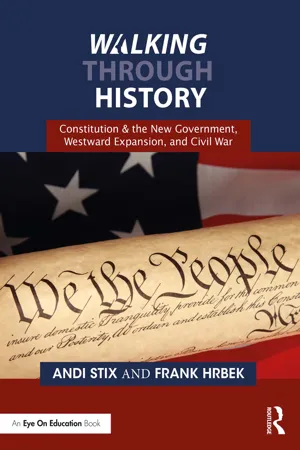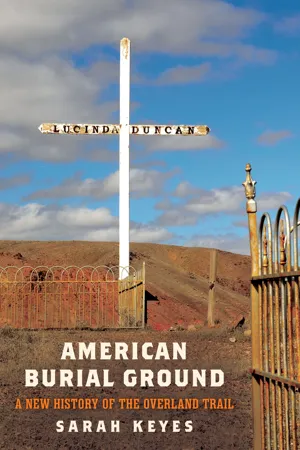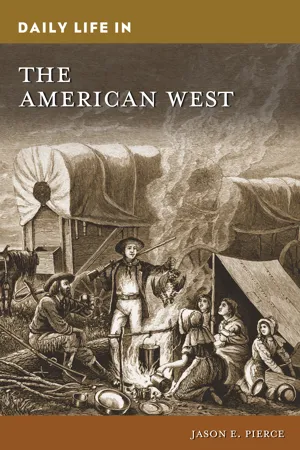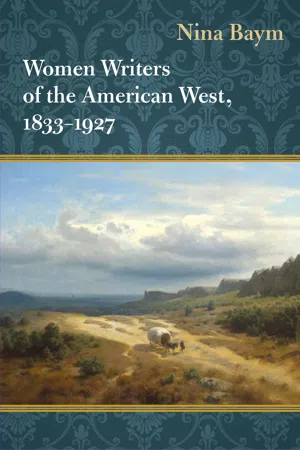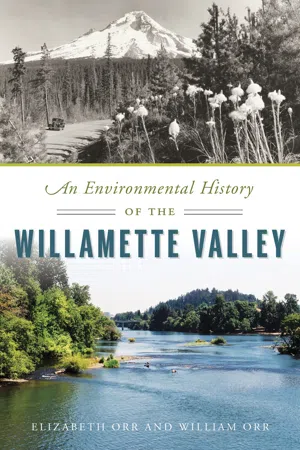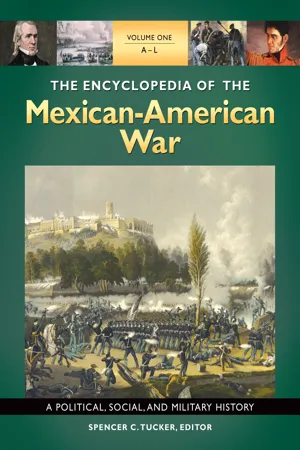History
Oregon Trail
The Oregon Trail was a historic route used by pioneers and settlers in the 19th century to travel from the Missouri River to Oregon. It stretched over 2,000 miles and played a significant role in the westward expansion of the United States. The journey was arduous and often perilous, with many facing challenges such as harsh terrain, disease, and Native American conflicts.
Written by Perlego with AI-assistance
Related key terms
7 Key excerpts on "Oregon Trail"
- eBook - ePub
Walking Through History
Constitution & the New Government, Westward Expansion, and Civil War
- Andi Stix, Frank Hrbek(Authors)
- 2023(Publication Date)
- Routledge(Publisher)
The Whitman mission, in the early 1830s, was the first realistic attempt at a settlement in the Oregon country. By the beginning of the next decade, there was a steady stream of thousands of Americans trekking the Oregon Trail. What originally had been a tiny trickle of emigrants soon became a flood. There may have been a treaty between England and the United States calling for joint occupancy of Oregon, but most Americans were willing to endure a convenient, momentary amnesia and go for it all. The prevailing attitude among these newcomers was the more emigrants making their homes in the Willamette River Valley, the better the chance of adding a new territory to our young country. These brash Americans were not shy and retiring; if anything, they were tinged with excessive pride.The Oregon Trail became the major artery of the Great Migration. Every year from the 1840s on into the 1850s, from late spring to early fall, thousands of families in long wagon trains would begin their journeys across the prairie. They climbed steadily to the high plains, wound through the mountains, and descended down to the coastal lands along the Pacific Ocean. Mormons used the trail to reach their religious haven at the Great Salt Lake. The Forty-Niners and others made a turn to the south at the California cutoff. Many more stuck with it all the way to the Columbia River in Oregon. The Oregon Trail was nineteenth century America’s great highway. It carried a steady, unending stream of traffic east to west and back again, from New York to Chicago, to Des Moines, Lincoln, Cheyenne, Salt Lake City, and on to San Francisco. The pioneers of yesteryear gathered at various cities in Missouri, such as Independence, St. Joseph, or Kansas City. They followed the Platte River west, through South Pass and across the Great Divide. Their journey continued through the Rockies and into the Great Basin. They endured the inferno of the Great Salt Lake Desert, followed the Snake River into the coastal ranges bordering the Pacific, and traveled down the Columbia. When the Great Migration finally ended, coinciding with the building of the first transcontinental railroad, close to half a million Americans had traveled west. - eBook - ePub
American Burial Ground
A New History of the Overland Trail
- Sarah Keyes(Author)
- 2023(Publication Date)
- University of Pennsylvania Press(Publisher)
Another pathway was the California Trail, a road that turned southwest away from the one the Kemps took northwest toward Oregon. These multiple migratory pathways across the continent merged into the singular “Overland Trail” because they were linked in people’s minds, then and now, to the same monumental transcontinental migration. While popular mythology typically depicts this migration as a caravan of covered wagons transporting men, women, and children across the sunny Plains, the Trail was a treacherous, often deadly trek that left a string of burials like Riley’s. 3 People of all ages died along the way. Cholera, which dominated the Trail experience during the early 1850s, killed the most emigrants. But overlanders also died of starvation, of dehydration, of dysentery, of other illnesses, and from exposure to the elements. Though a darker portrait of westward migration than we are used to, remembering, and uncovering the cultural significance of the dead—especially in laying claim to land that was inhabited by Indigenous peoples—is the goal of this book. Figure 1. The Overland Trail, 1838–69. This map shows many of the routes emigrants took in the nineteenth century. Map by Erin Greb Cartography There is perhaps no more shameful or significant process of nineteenth-century history than that of the violent incorporation of Native homelands into the U.S. dominion. Historians of Native America and, to a lesser extent, historians of the U.S. West have centered their attention on understanding the brutal, corrupt process through which a self-styled democratic republic wrested control of territory from Indigenous peoples and Mexico to triple its size in little more than five decades. 4 Land is what made the United States possible. Ownership of it opened doors for white men eager for equality while the fruits of it sustained slavery far longer in the United States than in most other republics. U.S - eBook - ePub
- Jason E. Pierce(Author)
- 2022(Publication Date)
- Greenwood(Publisher)
2DOMESTIC LIFE ON THE OVERLAND TRAILS
INTO THE WESTThe overland trails, especially the Oregon-California Trail, are iconic in American history. Movies, books, and a popular, but difficult, 1980s video game all recounted the adventure of the trail. Artists created monumental paintings of the trail experience on massive canvases meant to convey the enormity of the West, most notably Albert Bierstadt’s 1869 Emigrants Crossing the Plains, with its covered wagons and horsemen, flanked by imposing rock walls and ancient twisted trees, pushing inexorably into the ruddy setting sun. The covered wagon itself became a symbol of American progress and Manifest Destiny, and covered wagons still feature prominently in historic sites related to the trails, including on the symbol of the Oregon National Historic Trail. One can even “glamp” (luxury camping, a portmanteau for “glamorous camping”) in a covered wagon near Yosemite National Park for only $179 a night, according to Travel + Leisure magazine (Romano 2018).While we remember and romanticize the overland trail experience today, emigrants to Oregon and other destinations were keenly aware of the novelty of their experience—plucked from the daily chores of farm life, they embarked on a grand once-in-a-lifetime adventure—and subsequently a large number kept diaries, sent letters to loved ones, or wrote memoirs detailing their experiences later in life. Journeying west meant bettering their lives and helping expand the culture, values, and power of their nation. In effect, the vanguards of Manifest Destiny, the first emigrants in the 1840s to Oregon and California, entered territories that were still not yet the exclusive domain of the United States. Many felt this patriotic zeal and sense of national pride, even on the trail. Independence Rock, jutting out of the surrounding scrubland in southern Wyoming, became a common place of reverie. The name itself came from the belief that a wagon train should reach the rock by the Fourth of July if they hoped to arrive in Oregon or California before the snows came to the mountains. Winfield Scott Ebey felt a sense of national pride at Independence Rock on July 4, 1854. He wrote, “Crowds of emigrants got to the Rock, to spend Independence Day, and the loud reports of fire arms throughout the day, testifies that this is the birth Day [sic] of American Freedom; & that although here in the wilds of the Rocky Mountains, a thousand miles from our home we are Yet [sic - eBook - ePub
- Geraldine Bonner(Author)
- 2006(Publication Date)
- Perlego(Publisher)
The call of the West was a siren song in the ears of these waiting companies. The blood of pioneers urged them forward. Their forefathers had moved from the old countries across the seas, from the elm-shaded towns of New England, from the unkempt villages that advanced into the virgin lands by the Great Lakes, from the peace and plenty of the splendid South. Year by year they had pushed the frontier westward, pricked onward by a ceaseless unrest, "the old land hunger" that never was appeased. The forests rang to the stroke of their ax, the slow, untroubled rivers of the wilderness parted to the plowing wheels of their unwieldy wagons, their voices went before them into places where Nature had kept unbroken her vast and pondering silence. The distant country by the Pacific was still to explore and they yoked their oxen, and with a woman and a child on the seat started out again, responsive to the cry of "Westward, Ho!"As many were bound for Oregon as for California. Marcus Whitman and the missionaries had brought alluring stories of that great domain once held so cheaply the country almost lost it. It was said to be of a wonderful fertility and league-long stretches of idle land awaited the settler. The roads ran together more than half the way, parting at Green River, where the Oregon Trail turned to Fort Hall and the California dipped southward and wound, a white and spindling thread, across what men then called "The Great American Desert." Two days' journey from Independence this road branched from the Santa Fé Trail and bent northward across the prairie. A signboard on a stake pointed the way and bore the legend, "Road to Oregon." It was the starting point of one of the historic highways of the world. The Indians called it "The Great Medicine Way of the Pale-face."Checked in the act of what they called "jumping off" the emigrants wore away the days in telling stories of the rival countries, and in separating from old companies and joining new ones. It was an important matter, this of traveling partnerships. A trip of two thousand miles on unknown roads beset with dangers was not to be lightly undertaken. Small parties, frightened on the edge of the enterprise, joined themselves to stronger ones. The mountain men and trappers delighted to augment the tremors of the fearful, and round the camp fires listening groups hung on the words of long-haired men clad in dirty buckskins, whose moccasined feet had trod the trails of the fur trader and his red brother. - eBook - ePub
- Nina Baym(Author)
- 2011(Publication Date)
- University of Illinois Press(Publisher)
A Picked Company (1912) installs New Englanders as the core of the best western type. A New England minister gathers said picked company for Oregon travel to realize the perfect life, just as the New England Puritans had gathered for travel to the New World. These voyagers have no interest in Natives, who pry, pilfer, run off cattle, and beg; they are “feathered Gentlemen of the Road” with faces blacked for murder (114), sinister suppliants “dangerous to refuse” (283). The noble goal is linked to the antislavery cause, a connection not seen in the writing of any Oregon woman I found. According to this novel, in response to the antislavery clause in the Oregon constitution submitted to Congress, the North “did not wait to win the fight in Congress” but “sent men of brains and character, who moved their families out there, on the ground, making the venture a species of crusade. They were helping to anchor the future State in principles of a nation’s faith as dear to them as their fathers’ religion.… The great pathway had been cut from ocean to ocean; toil of countless feet of men and cattle with sweat and blood had worn it wider, every year” (405–6). Marcus Whitman—who couldn’t possibly have met this group at the time they are said to have been crossing the plains (but the historical novel as a genre almost always introduces historical counterfactuals like this; it must do so because its characters are otherwise fictive) arrives on the scene to assure the group that whatever negatives they’ve heard about Oregon emanate from Hudson’s Bay Company propaganda designed to discourage American emigration. En route the picked company is augmented by gamblers, sexually loose women, and killers; bitter rivalries emerge, people are expelled from the train, there are murders. Two couples represent the virtuous and the vicious, and at the fork in the road past Fort Laramie, the undesirables opt for California while the New Englanders remain true to Oregon: “builders for the Northwest, gamblers for California” (406), says the narrator; “we think that the builders will always have the last word in any true story or one that pretends to be true,—though the gamblers shall be there, foremost in every race for achievement or possession: they run as torch-bearers, and end as incendiaries who perish in their own fires” (401). So Oregon is posited as New England, while California is written off the map.Because the Santa Fe trail ran through Kansas, and because the Kansas DAR made it a project to mark the trail across the state, a couple of Kansans wrote trail stories mostly about Kansas. I suggested in Chapter 7 that this endeavor defended in part against the redefinition of Kansas and Nebraska as Midwestern, a designation depriving them of all western glamour. Kate Aplington’s Pilgrims of the Plains: A Romance of the Santa Fe Trail (1913) takes the form of a journal kept by a woman on the trail, who goes because her seventeen-year-old invalid brother needs care. She finds romance with a German scientist looking for botanical specimens. The story involves furtive and treacherous Mexicans, stolid and vengeful Indians, upstanding ethical Scots, singing Negroes. Standard landscape descriptions include tornado, rainstorm, heat, and fine pure prairie air. “The wide prairies are glorious! The wind salutes us with a sweet, fresh kiss as it passes.… The rank grasses are already more than waist high.… And this lovely country hasn’t even a name!” (130). At the end of the journey, the protagonist looks “upon the men grouped about us, and they were not as I had seen them day by day. I saw them as those who are yet to be born will see them! They are Heroes,—the Conquerors of the Wilderness - Elizabeth Orr, William Orr(Authors)
- 2019(Publication Date)
- The History Press(Publisher)
The ultimate outgrowth of extending rail lines in the 1870s and highways in the 1930s was to encourage the spread of suburbanization and industrialization. The easy mobility allowed people and businesses to leave the central downtown core and take over new areas throughout the province.TRAILS WESTWARDTrails led immigrants to their destination: the Willamette Basin in the Oregon Territory. Toward the end of their two-thousand-mile-long journey, wagon parties were confronted by their most difficult ordeal, finding a way across the formidable Cascades, a mountain chain that stretches north–south the length of the state. No matter where they sought to homestead, a passage was needed that would lead them over the crest.74As natural conduits through the mountains, river valleys became the roadways for wagon trains. Authors’ diagram.Of the five main routes, four followed rivers: the Oregon Trail, along the channel of the Columbia River, was the earliest to breach the Cascade Mountains in 1841. Five years later, the Applegate Trail, the only one that failed to follow a major waterway, opened through the southwestern part of the state. More than twenty years passed before traffic entered the central and upper basin on the Willamette Valley and Cascade Mountain Wagon Road along the South Santiam River. The Free Emigrant and the Oregon Central Military Roads on the Middle Fork of the Willamette opened in 1870 and the Salt Springs and Des Chutes Wagon Road on the McKenzie River in 1871.The Columbia River Route: The Oregon TrailThe Oregon Trail was first marked out by Robert Stuart and a party of six companions, who started eastward from the fur trading post at Astoria in June 1812. Carrying letters for the North West Fur Company, they were on an overland journey to St. Louis, a perilous ordeal lasting nine months. Robert Stuart’s course up the Columbia, to the Snake River, through Idaho and eastward across the Continental Divide at South Pass, Wyoming, became the most heavily traveled and earliest means of reaching destinations in western Oregon.75- eBook - ePub
The Encyclopedia of the Mexican-American War
A Political, Social, and Military History [3 volumes]
- Spencer C. Tucker, Spencer C. Tucker, Spencer C. Tucker(Authors)
- 2012(Publication Date)
- ABC-CLIO(Publisher)
The flood of Americans into Oregon encouraged U.S. expansionists to call for its outright annexation. They believed the United States had a Manifest Destiny to stretch from ocean to ocean. The most extreme expansionists called for U.S. ownership of the complete Oregon Territory, all the way to the 54 degree 40 minute latitude. In the 1844 presidential campaign, James K. Polk supported this claim, which helped him defeat the Whig candidate, Henry Clay. After the election, Polk offered in July 1845 to compromise with Great Britain by establishing a border at the 49th parallel. His first offer was rejected, and Polk then took a harder line, and expansionists adopted the slogan “Fifty-four forty or fight.” By the beginning of 1846, however, tempers had cooled somewhat. War with Mexico was looming, and Polk was not eager to undertake two wars at once. With the numbers of fur-bearing animals dwindling in Oregon, the British were not willing to fight a war over its possession. When the British government signaled that it was willing to divide Oregon along the 49th parallel, Polk accepted. He asked the Senate to ratify the treaty, and on June 15, 1846, the treaty was signed.Illustration of Astoria, Oregon, and the Columbia River in 1841. (Charles Wilkes, Narrative of the United States Exploring Expedition , vol. 5, 1845)Oregon was formally organized into a territory in 1848. It later became the modern states of Oregon, Washington, Idaho, parts of Wyoming, and Montana.TIM WATTSSee also Adams-Onís Treaty; Expansionism and Imperialism; Great Britain; Louisiana Purchase; Manifest Destiny; Oregon Boundary Dispute; Oregon Trail; Oregon Treaty; Polk, James Knox.References
Merk, Frederick. The Oregon Question . Cambridge, MA: Belknap Press of Harvard University, 1967.Pletcher, David. The Diplomacy of Annexation: Texas, Oregon, and the Mexican War . Columbia: University of Missouri Press, 1973.Oregon Trail
The primary route for settlers emigrating to the Northwest between 1840 and 1860. Beginning in Independence, Missouri, the 2,000-mile-long Oregon Trail extended through the Great Plains and Rocky Mountains. Settlers joined wagon trains in Independence and then trekked for five or six months before reaching their destination.The movement of settlers to Oregon, as well as Texas, was part of a sizable movement of Americans to the far western regions of North America between 1840 and 1860. An estimated 300,000 Americans traveled west seeking new opportunities during those two decades, most of them coming from the Old Northwest. The majority of these travelers were white, although some blacks did migrate to the West. In general, these people traveled in family groups, with the exception of the single men attracted by the California Gold Rush, which began in 1848.Most of these new settlers were fairly prosperous; some were even wealthy. Poorer travelers tended to join wagon trains as laborers in order to afford the trek west. Groups heading toward the western regions, where lumber and mining provided the majority of jobs, tended to be made up of men, while farmlands attracted families, including women and girls.
Index pages curate the most relevant extracts from our library of academic textbooks. They’ve been created using an in-house natural language model (NLM), each adding context and meaning to key research topics.
